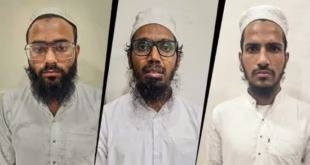New Delhi;Feb’25-The target is a service level rate of 55 litres per capita per day with tap water accessibility to 100% across the country.In just 2 and half years, the Jal Jeevan mission has changed the face of tap water availability in the country. On August 15, 2019, Prime Minister Narendra Modi announced the most ambitious water programme in Indian history – the Jal Jeevan mission. India is expected to spend Rs. 3.50 lakh crore (US$ 46.5 billion) for the programme. The aim is to provide functional tap water across every state and union territory by 2024.
India’s Jal Jeevan mission aims to strengthen the existing water sources to set up various treatment plants and desalination plants in the coastal regions. The mission also aims that the existing water supply and connections are functional, water quality is maintained, and sustainable agriculture is achieved. It ensures the conjunctive use of conserved water, drinking water source augmentation, drinking water supply system, greywater treatment, and reuse.
India is among the top-10 water-rich countries in the world, with access to about 4% of the world’s water resources. Only 4 percent of water is used for drinking purposes, while 80 percent of the water is used in agriculture. India’s water demand is increasing throughout the country, because of rapid population expansion, urbanisation, and rising living standards.
The Challenge
According to The Energy and Resources Institute (TERI) data, growth in the urban population led to the additional water demand of 12,420 million litres per day (MLD) in 2018. The country’s water demand is expected to grow by 77% from 710 billion cubic metres (BCM) in 2010 to 1180 BCM by 2050.
To get an idea of the kind of change this programme has brought about, It is pertinent to visit the fact that as of 2015, 16.3 crore people in India lacked access to clean water. It was the highest in any country. NITI Aayog had once claimed that India is suffering from the worst water crisis in its history and millions of lives and livelihoods are under threat. “Currently, 600 million Indians face high to extreme water stress and about two lakh people die every year due to inadequate access to safe water.” It was estimated the crisis is going to get worse by 2030 when India’s demand is projected to be twice the available supply.
Jal Jeevan Mission
The government created the Ministry of Jal Shakti to look after water-related issues. This Ministry deals with work of the Ministry of Water Resources, River Development and Ganga Rejuvenation and Ministry of Drinking Water and Sanitation. The Jal Jeevan mission, by ensuring that individuals in need of water have access to it. The piped drinking water supply for rural households, in sufficient amounts and of approved quality on a regular and long-term basis, which is a critical component of the Jal Jeevan mission, benefits women and young girls in particular, who travel long distances to fetch water. The comprehensive view incorporates that the newfound time is utilised for income generation, tourism improvement, skills improvement, and supporting child education. This will also result in improved rural communities’ living conditions.
Jal Jeevan Mission aims to develop an expansion of existing water sources to provide long term water sustainability in the country. This also reduces the stress on traditional water sources and helps India to tackle the impending climate crisis. The programme also takes steps towards greywater management.
The mission aims to reduce water contamination and address the issue with the help of technology. The programme also aims to support activities like water testing facilities, research and development and knowledge centres. Jal Jeevan mission has over 2,018 active laboratories for testing the water quality.
The structure of the Jal Jeevan Programme includes various levels of state, district and village level action plans as State Action Plan (SAP), District Action Plan (DAP) & the Village Action Plan (VAP).
The Achievements
Since August 15, 2019, over six states in India have achieved 100% Functional Household Tap Connection (FHTC). These states include Goa, Telangana, Andaman and Nicobar Islands, Puducherry, Dadra and Nagar Haveli, Daman & Diu, and Haryana. This includes over 96 districts, which have over 132,134 villages. Five crore households have been provided with water connection since the launch of Jal Jeevan Mission in 2019 and now tap water is reaching every household in about 1.25 lakh villages as on 2nd october, 2021.
As the Prime Minister Narendra Modi has said, “The mission was village-driven and its vision was not just to make water accessible to the people, but it was also a big movement of decentralisation. Today’s India has done more work on this front in just two years than what was done in seven decades.”
Along with the Jal Jeevan Mission. Additionally, the Rashtriya Jal Jeevan Kosh was also launched, through which any individual, institution, corporate or philanthropist, be it in India or abroad, can contribute to providing tap water connection in every rural household, school, Anganwadi centre, Ashram Shala and other public institutions.
Since the launch of the Jal Jeevan Mission, more than 7.1 lakh women have been trained to test the quality of water by using field test kits. In the aspirational districts, the number of tap connections has increased from 31 lakh to 1.16 crore.
 Pressmediaofindia
Pressmediaofindia



